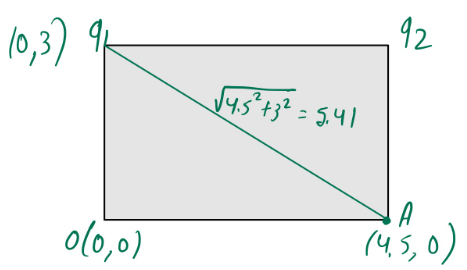Question

Transcribed Image Text:(2-10) A charge q1 = -5 µC is located at (x,y)=(0,3) m. Another charge of q2 = +4 µC is
located at (4.5,3) m.
O (0,0)

Transcribed Image Text:9. What is the electric potential due to the charges q, and q2 at the point (4.5, 0) m?
Expert Solution
arrow_forward
Step 1

We know that electric potential is calculated as,
are the distance between and A & and A respectively.
Here
Step by stepSolved in 2 steps with 1 images

Knowledge Booster
Similar questions
- A charge of uniform density (29 nC/m) is distributed along the x axis from the origin to the point x = 18.3 m. What is the electric potential (relative to zero at infinity) at a point, X = 73.6 m, on the x axis?arrow_forwardThree point charges are placed on the x-axis. 30 µC at the origin, -56 µC at x=0.292 m, -85 µC at x = 0.96 m. Find the magnitude and direction of the net force acting on -56 µC charge. What is the electric potential at (0, 0.96m)? What is the electric field at (0, 0.96m)?arrow_forwardIn the figure, three thin plastic rods form quarter-circles with a common center of curvature at the origin. The uniform charges on the three rods are Q = 30 nC, Q, = 3•Q1, and Q3 = 8.Qj. What is the net electric potential at the origin due to the rods? Give your answer in volt. (ke = 1/4ne, = 9.0 x 10° Nm²/C?) y (cm) 4.아 2.0 1.0 - x (cm) %3Darrow_forward
- Two point charges, +2.70 µC and -7.40 μC, are separated by 1.70 m. What is the electric potential midway between them? Number i Toxtbook and M Unitsarrow_forwardTwo point charges, Q1 = -5.00 μC and Q2 = +3.00 μC, are separated by 55.0 cm. Calculate the electric potential at a point midway between the charges.arrow_forwardIn the figure a plastic rod having a uniformly distributed charge Q = -20.5 pC has been bent into a circular arc of radius 1.94 cm and central angle 120°. With V = 0 at infinity, what is the electric potential in volts at P, the center of curvature of the rod? R Units V Number i 9.51arrow_forward
- Two point charges are arranged at the vertices of a rectangle as shown below where q₁ = 2.00 μC and q2 = -2.00 μC. What is the potential at point a, located at the center of the rectangle, and the potential at point b, located at the adjacent corner of charge 92. 91 92 0.50 m a 1.0 m barrow_forwardTwo point charges, +3.90 μC and -8.90 μC, are separated by 3.50 m. What is the electric potential midway between them?arrow_forwardFor a point charge, the equipotential surfaces form concentric spheres with the charges at the center. 2 such equipotential surfaces have potentials 293.3V and 95.2V. if these 2 concentric surfaces are separated by a distance of 2.2m, what is the charge of the point particle?arrow_forward
- please include how you got the answerarrow_forwardTwo point charges, Q = +5.60 μC and q = −2.10 μC, are separated by 5.0 m. What is the electric potential energy?arrow_forwardTwo point charges Q₁ = - -2.92 μC and Q2 = 2.52 µC are shown in the figure. Q₁ is located at (-2.1 cm, 0.0 cm) while Q2 is at (0.0 cm, — 2.6cm)). Use k = 9.0 × 10⁹ Nm²/C² (A) Find the electric potential at the origin. V = (B) If a -2.81 nC charge with a mass of 12.3 g is released from rest at the origin, how fast will it be moving when it is very far away from the charges? V = (C) If a proton is released from rest very far away from the charges shown above, how fast would it be moving at the origin? V =arrow_forward
arrow_back_ios
arrow_forward_ios